
Original Link: https://www.anandtech.com/show/2360
Transcend TS16GSSD34E: SSD ExpressCard for those on the Go...
by Dave Robinet on October 25, 2007 12:15 AM EST- Posted in
- Storage
Introduction
As the price/performance ratio of solid state memory continues to improve, so does the list of companies looking to find new uses for devices built around the technology. While some of the implementations of the technology have been obvious (memory for small portable devices like cameras and phones, for example), some of the other uses for solid state memory are only now becoming practical. One such implementation has been realized recently, in the form of ExpressCard-based portable storage.
CardBus - The Legacy
When the CardBus standard was released in 1995, PCI connectivity was the fastest common slot interface in use for machines. CardBus therefore leveraged the existing PC Card standard (85.6mm long, 54.0mm wide) and created a bus to the PCI host. The resulting 68 pin cards which attached to the CardBus slot were subject to physical failure, and always suffered from having to interface their internal circuitry with a fairly complex (and expensive) connector at the end of its interface.
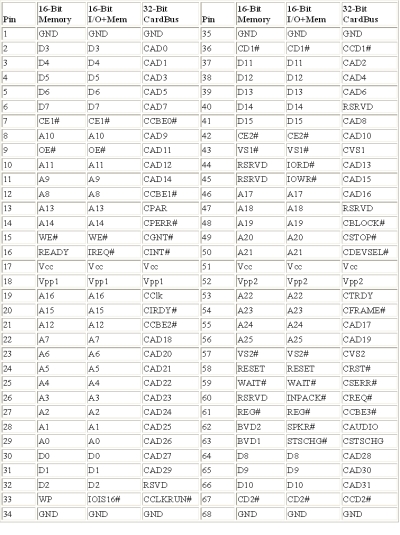
Despite the difficulties in using these connectors, CardBus modules performed a variety of functions for laptop users with relatively good levels of success. As time passed, however, the PCI standard slowly began to fall out of favor compared to USB and PCI-Express. With an eye to improving the lot in life of laptop users who were frequently attaching USB devices to their laptops which stuck out of connectors, as well as answering the increasing call from manufacturers who were concerned about PCI's life expectancy becoming shorter and shorter, the PCMCIA governing body created a new standard: ExpressCard.
ExpressCard - A New Standard
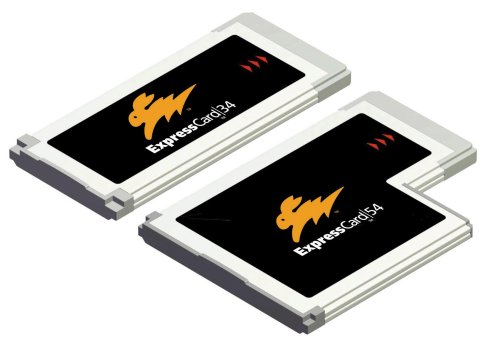
ExpressCard introduces two new packaging formats for laptops, in the form of ExpressCard/34 (34mm wide, 75mm long) and ExpressCard/54 (54mm wide, 75mm long). Both ExpressCard/34 and ExpressCard/54 share the same end connector and performance characteristics, though ExpressCard/54 was designed to allow for more internal space for the card, larger external connectors (if required by the ExpressCard module) as well as greater surface area for heat dissipation.
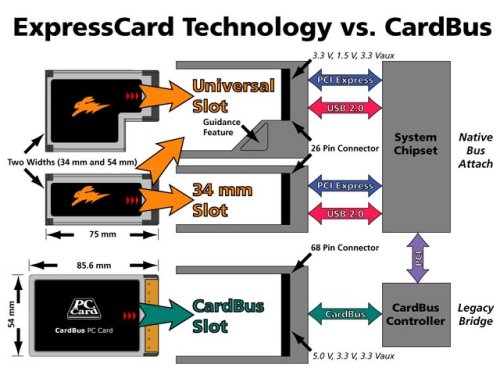
The ExpressCard standard mandates that each slot have the ability to interface either with the USB host (USB 2.0), or with a dedicated PCI-Express x1 lane. The choice of host interface is made by the attached ExpressCard module itself, and data flows over the appropriate signal pathways in the interface. This allows manufacturers to continue to leverage their existing devices which have already been developed with either USB or PCI-Express in mind, and provide a new packaging for the devices which allows for laptop usage.
Let's take a look at the Transcend ExpressCard SSD and see how it performs today.
ExpressCard Specifications
The maximum performance of ExpressCard devices depends on which interface the manufacturer has chosen to use:
PCI Express: 2.5Gbit/sec/direction
USB 2.0: 480 Mbit/sec
Providing hardware manufacturers the ability to choose between the USB 2.0 interface (which is fairly easy to implement) and a dedicated PCI-Express x1 interface (which is somewhat more complex, but offers obvious performance benefits) gives ExpressCard flexibility which had not been seen in laptops up to that point. It also allows for high performance applications which were unheard of during the PC Card era - for example, Magma offers an external adapter which allows for the connection of a single wide PCI-Express graphics card to a laptop.
Laptop manufacturers have been adding ExpressCard support recently, though most are continuing support for their existing PC Card interfaces to allow users to gradually wind down their investment in legacy PC Card hardware. As the two slots are physically incompatible, this is a trend which is likely to continue for some time.
The Transcend TS16GSSD34E
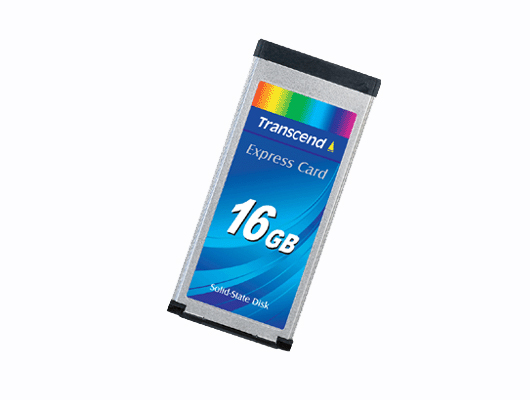
Transcend introduced their ExpressCard SSD line in March of 2007, with capacity options varying from 2GB to 16GB in size. They have since refined this offering to three choices: 8GB, 16GB, and 32GB. For this, they are using the ExpressCard/34 packaging, and opted to interface with the USB 2.0 host.
Specifications
| Drive Specifications - Transcend TS16GSSD34E | |||
| Manufacturer's Stated Capacity | 16GB | ||
| Operating System Stated Capacity | 15.5 GB | ||
| Interface | USB 2.0 | ||
| Operating Voltage | 3.3V | ||
| Operating Temperature | 0°C(32°F) to 70°C(158°F) | ||
| Weight | 19g | ||
| Read Performance | 18MB/s | ||
| Write Performance | 8MB/s | ||
| Power Draw Idle / Load | .46W / 1.08W | ||
| Acoustics Idle / Load | 0 dB(A) / 0 dB(A) | ||
| Thermals Idle / Load | 25C / 26C | ||
| MTBF Rating | 2,000,000 hours | ||
| Data Retention | 10 years | ||
| Warranty | 2 Years | ||
While the transfer rate is nothing exceptional, the solid state memory found in the TS16GSSD34E provides access times of less than 1ms, and the ExpressCard packaging means that the device will not stick out of your existing laptop. The low power requirements of the unit, minimal heat dissipation, and light weight of the module all make it a potential option for users with low storage requirements who may wish to replace the internal hard drive in their laptop. (Note: Check your laptop's BIOS for boot options - not all laptops will allow booting from an ExpressCard device).
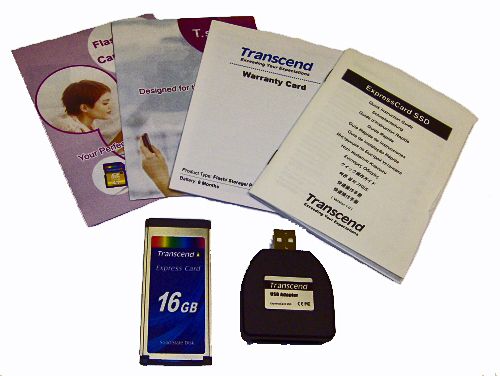
The Transcend TS16GSSD34E comes packaged with the ExpressCard module itself, a USB-ExpressCard adapter which allows the device to be connected to a standard USB 2.0 port, the product manual, warranty card, and an assortment of Transcend product advertisements. The manual is laughably short, providing nuggets of information such as "Once you have completed installing the SSD34E, you can see that the installation was successful". The USB adapter for the SSD34E seems somewhat bulkier than it needs to be, though the ExpressCard fits nicely into the slot. No incompatibilities were observed either in our test bed system or a Lenovo T60 laptop in our labs while using the USB adapter.
Test Setup
| Desktop Test Bed | |
| Processor | Intel E6600 - 2.4GHz 4MB Dual-Core |
| Motherboard | Gigabyte GA-P35-DQ6 |
| RAM | 2 x 1GB OCZ Reaper HPC PC2-6400 Settings: DDR2-800 @ 4-4-3-10 |
| OS Hard Drive | 1 x Western Digital WD1500 Raptor - 150GB |
| System Platform Drivers | Intel 8.3.0.1013 Intel Matrix RAID 7.6.0.1011 |
| Video Card | 1 x MSI 8800GTX |
| Video Drivers | NVIDIA ForceWare 162.18 |
| Optical Drive | Plextor PX-760A, Plextor PX-B900A |
| Cooling | Tuniq 120 |
| Power Supply | Corsair HX620W |
| Case | Cooler Master CM Stacker 830 |
| Operating System | Windows XP SP2 |
We are using an Intel E6600 dual core CPU to ensure we are not CPU limited in our testing. We've used a 2GB memory configuration for these tests, but will soon be updating our test beds to a consistent 4GB platform due to current DDR2-800 pricing and upcoming game and application requirements. Our choice of budget level OCZ Reaper HPC PC2-6400 memory offers a very wide range of memory settings with timings of 4-4-3-10 used for our storage benchmark results.
The MSI 8800GTX video card in our system ensures that our 1280x1024 resolutions are not GPU bound for our test results. Our video tests are run at 1280x1024 resolutions for this article at High Quality settings. All of our tests are run in an enclosed case with a dual optical/hard drive setup to reflect a moderately loaded system platform. The OS is fully updated and we load a clean drive image for each platform to keep driver conflicts to a minimum.
The test drive is formatted before each test run and five tests are completed on each drive in order to ensure consistency in the benchmark results. The high and low scores are removed with the remaining score representing our reported result. The Windows XP swap file is set to a static 2048MB and we clean the pre-fetch folder after each benchmark.
For these tests, we will be using the USB adapter for use with our test-bed system. To be sure this would not produce a bottleneck, we compared the performance of the unit with and without the USB adapter in an ExpressCard-equipped Lenovo T60 laptop in our labs, and found the performance to be virtually identical. Given that this module uses the USB host for its ExpressCard interface, this is an expected result.
We will also be including results from an MXI ClipDrive 2.0 USB stick which we use in our labs for comparison purposes.
HDTach and HDTune
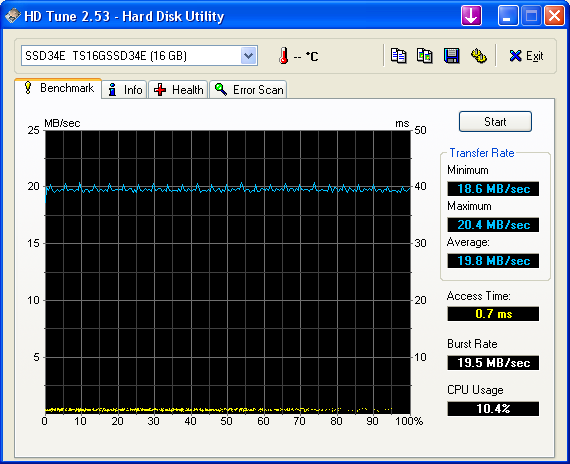
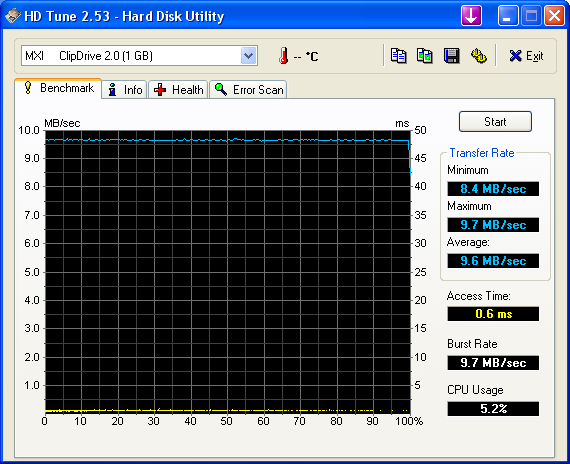
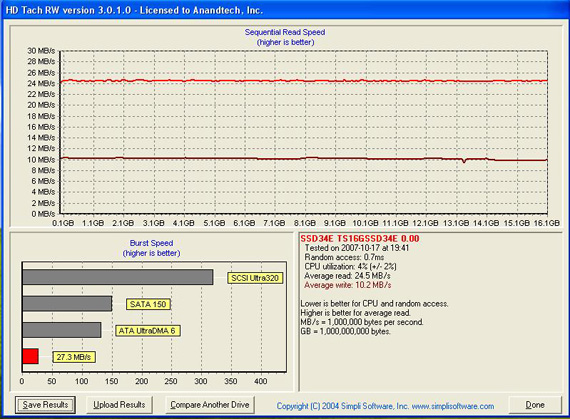
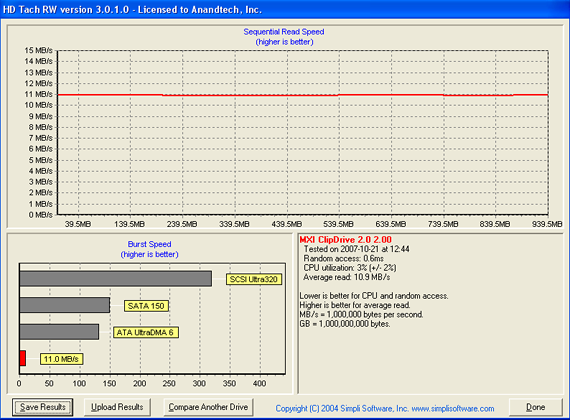
While certainly not a threat to a conventional hard drive, the SSD34E shows synthetic numbers at or above its posted specifications. There is clearly ample bandwidth in the USB bus to support the device. The MXI ClipDrive 2.0 used for comparison purposes, while not exactly a world beater, turns in speeds approaching 10MB/second for both reads and writes.
File Write Performance
Our file copy test measures the time it takes to transfer our test folder that contains 29 files, 1 folder, and has 7.55GB of data from our source (WD Raptor) drive to the target test drive. This benchmark is disk write intensive and requires a fast storage system.
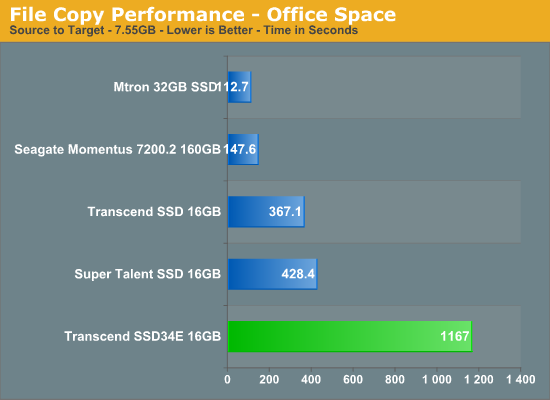
Where the SSD34E's performance suffers the worst is in the area of file writes. Our test showed it took 19 minutes and 7 seconds (1167 seconds) to write the 7.55 gigabytes of data. This measures out to be about 6.8MB/second, which is a fair bit slower than the posted specs for the device. As the 7.5GB file set was too large for our MXI Clipdrive, we were unable to include it in this test.
WinRAR 3.70
The first of our WinRAR tests measures the time it takes to compress our test folder that contains 444 files, 10 folders, and 602MB of data from our source WD Raptor drive to the target drive. In order to preclude other components (ie. the CPU) from being a factor in this test, WinRAR was set to "store" - this mode offers no actual file compression, but instead simply puts all of our test files into a single RAR archive. The resulting benchmark therefore highlights the write performance of the device in question.
We then extract the archive to a different location on the same drive, giving a benchmark which shows not only the read and write performance, but is also influenced by the seek times of the devices, since the drive must continuously move from position to position.
WinRAR Create/Extract Archive Test
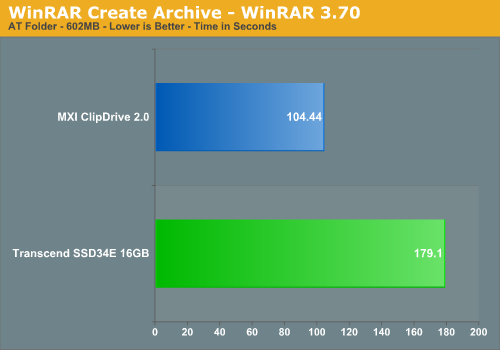
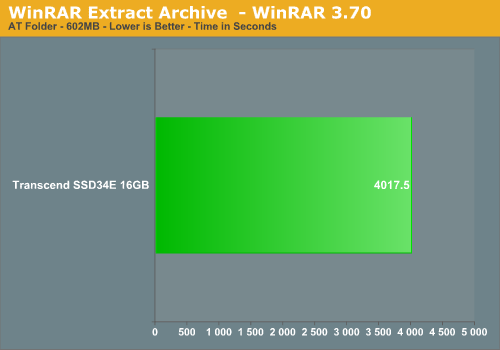
The SSD34E performs the store operation in 2 minutes and 59 seconds - not only is this far behind the Samsung T166 drive at 10.06 seconds, but even the fairly generic MXI ClipDrive used for USB 2.0 comparison turns in a substantially faster performance. Clearly, this is a disappointing result for the SSD34E.
The archive extraction portion of the benchmark truly makes the SSD drive look awful. It took over 22 times as long to perform the "extract" operation when compared to our Samsung T-166 at 10.15 seconds, which is an absolutely astonishing figure.
Since our standard test folder wouldn't fit on our smaller MXI drive, we ran a smaller 100mb extract on it. We found that this smaller operation took 12 times as long on the MXI drive. Surprised at the results, we ran this same 100mb archive on the Transcend ExpressCard, and found that the 12:1 ratio did indeed carry over to the Transcend device:
WinRAR Smaller File Create/Extract Archive Test
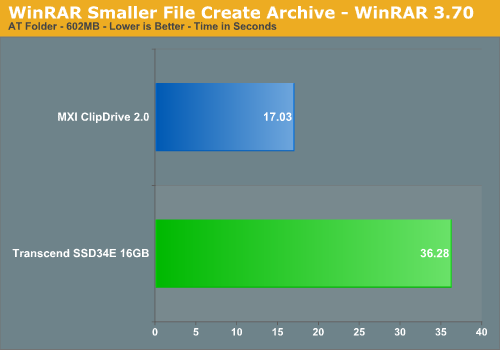
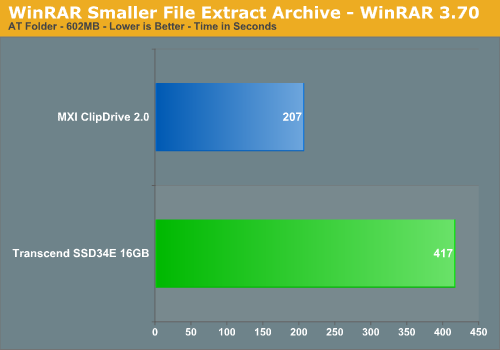
While it is somewhat reassuring that the Transcend ExpressCard isn't bested in terms of the increased extract time ratio, the reality is that it is still trounced soundly by the fairly standard MSI ClipDrive.
Conclusion
The Transcend TS16GSSD34E is truly a mixed bag. For $170 USD (street) price, the user receives a device which provides a decent storage option for laptop users with an ExpressCard slot, though the sheer size of the ExpressCard and USB adapter assembly makes it a bit cumbersome to frequently use as an external USB device while traveling.
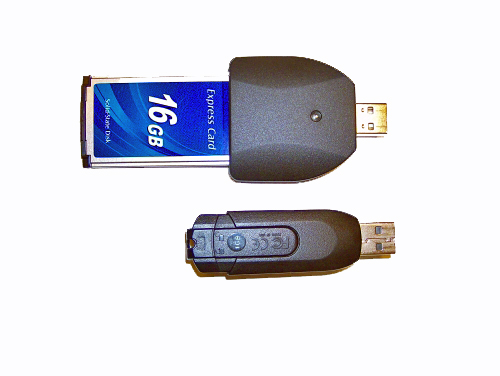
The true value of the SSD34E is in its use as an ExpressCard device. Any "road warrior" who has used a laptop with a USB stick has found it awkward at times - and the SSD34E resolves this issue by having the storage fit inside the laptop's slot. When a user wants to share the data with someone else, they simply pop it out of the slot, attach the USB adapter, and the SSD34E can be used in whatever setting a USB stick can. This allows for something which has thus far eluded laptop users - a means of having easy and fast removable storage at their fingertips the entire time, without sacrificing any of the convenience of their physical laptop footprint.
Performance-wise, the SSD34E was a bit of a disappointment although it does come very close to matching Transcend's performance figures. Its 16GB of capacity is much larger than most standard USB stick sizes which can be purchased in bulk at your local electronics store, though again, the overall cost was certainly substantially higher than those units. On a per-gigabyte basis, however, the 16GB SSD34E shows up fairly well.
It's tough to recommend a unit like the TS16GSSD34E, as the write performance is just too serious a drag on what would otherwise be a solid package. The use of ExpressCard packaging is an excellent idea - and an idea which has been under-represented in the market place today. The 16GB of space could certainly make this device far more useful than a conventional memory stick, and the $170 street price means that the product hovers around the $11 per gigabyte mark. We certainly expect better performance out of a device that we would use frequently so there just are not enough redeeming qualities to fully recommend the TS16GSSD34E at this point in time. However, a faster controller design or a lower price would certainly have us changing our conclusion.







